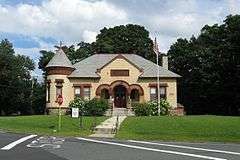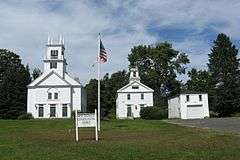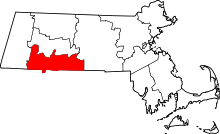Granville, Massachusetts
| Granville, Massachusetts | ||
|---|---|---|
| Town | ||
|
Old Meeting House | ||
| ||
 Location in Hampden County in Massachusetts | ||
| Coordinates: 42°04′00″N 72°51′43″W / 42.06667°N 72.86194°WCoordinates: 42°04′00″N 72°51′43″W / 42.06667°N 72.86194°W | ||
| Country | United States | |
| State | Massachusetts | |
| County | Hampden | |
| Settled | 1736 | |
| Incorporated | 1754 | |
| Government | ||
| • Type | Open town meeting | |
| Area | ||
| • Total | 43.0 sq mi (111.3 km2) | |
| • Land | 42.2 sq mi (109.4 km2) | |
| • Water | 0.7 sq mi (1.9 km2) | |
| Elevation | 685 ft (209 m) | |
| Population (2000) | ||
| • Total | 1,521 | |
| • Density | 36.0/sq mi (13.9/km2) | |
| Time zone | Eastern (UTC-5) | |
| • Summer (DST) | Eastern (UTC-4) | |
| ZIP code | 01034 | |
| Area code(s) | 413 | |
| FIPS code | 25-26675 | |
| GNIS feature ID | 0618183 | |
| Website | www.townofgranville.org | |
Granville is a town in Hampden County, Massachusetts, United States. The population was 1,566 at the 2010 census. It is part of the Springfield, Massachusetts Metropolitan Statistical Area. The town is named for John Carteret, 2nd Earl Granville.[1]
History and description
Granville was first settled by English colonists in 1736 and was officially incorporated in 1754, after the end of the Indian wars in 1750. Early settlers could get a 100-acre (0.40 km2) lot for free, providing they built a house and "put four acres in English hay". Perhaps the most famous resident of that era was Oliver Phelps, whose purchase of 6 million acres (24,000 km2) in western New York (Phelps and Gorham Purchase) following the American Revolutionary War remains the largest real estate purchase in US history. The population in Granville expanded quickly, peaking at 2100 in 1810, when it rivaled Springfield. However, likely due to the rocky soil in New England, many settlers eventually migrated west, some establishing the town of Granville, Ohio.
Many historic homes dot Route 57, the main road through town. The village center, the old center, and West Granville center, are all designated as historic districts listed on the National Register of Historic Places. Historic buildings include Granville's Old Meeting House (superb acoustics), the Stevenson house to its west, the West Granville Academy, and the West Granville Church. The village center features an old-fashioned country store, known for its cellar-aged cheese.[2]
In addition to period architecture, Granville is the watershed for three reservoirs: Barkhamsted, the main source for the Hartford metropolitan district; Cobble Mountain, the main source for the city of Springfield; and Westfield, the main source for the city of Westfield, Massachusetts. Much of the land in town is owned by the various water districts. Granville also has a number of active apple orchards.
Geography
According to the United States Census Bureau, the town has a total area of 43.0 square miles (111 km2), of which 42.2 square miles (109 km2) is land and 0.7 square miles (1.8 km2) (1.70%) is water.
Granville is bordered on the north by Blandford and Russell, on the northeast by Westfield, on the east by Southwick, on the south by Granby, Connecticut and Hartland, Connecticut, and on the west by Tolland.
Demographics
| Historical population | ||
|---|---|---|
| Year | Pop. | ±% |
| 1850 | 1,305 | — |
| 1860 | 1,385 | +6.1% |
| 1870 | 1,293 | −6.6% |
| 1880 | 1,205 | −6.8% |
| 1890 | 1,061 | −12.0% |
| 1900 | 1,050 | −1.0% |
| 1910 | 781 | −25.6% |
| 1920 | 655 | −16.1% |
| 1930 | 674 | +2.9% |
| 1940 | 668 | −0.9% |
| 1950 | 740 | +10.8% |
| 1960 | 874 | +18.1% |
| 1970 | 1,008 | +15.3% |
| 1980 | 1,204 | +19.4% |
| 1990 | 1,403 | +16.5% |
| 2000 | 1,521 | +8.4% |
| 2010 | 1,566 | +3.0% |
| * = population estimate. Source: United States Census records and Population Estimates Program data.[3][4][5][6][7][8][9][10][11][12] | ||
As of the census[13] of 2000, there were 1,521 people, 556 households, and 409 families residing in the town. The population density was 36.0 people per square mile (13.9/km²). There were 595 housing units at an average density of 14.1 per square mile (5.4/km²). The racial makeup of the town was 98.69% White, 0.26% African American, 0.20% Asian, 0.39% from other races, and 0.46% from two or more races. Hispanic or Latino of any race were 0.66% of the population.
There were 556 households out of which 36.9% had children under the age of 18 living with them, 63.7% were married couples living together, 6.8% had a female householder with no husband present, and 26.3% were non-families. 20.9% of all households were made up of individuals and 8.8% had someone living alone who was 65 years of age or older. The average household size was 2.73 and the average family size was 3.19.
In the town the population was spread out with 27.6% under the age of 18, 4.9% from 18 to 24, 31.1% from 25 to 44, 25.4% from 45 to 64, and 10.9% who were 65 years of age or older. The median age was 39 years. For every 100 females there were 106.9 males. For every 100 females age 18 and over, there were 100.9 males.
The median income for a household in the town was $53,148, and the median income for a family was $59,219. Males had a median income of $42,273 versus $30,380 for females. The per capita income for the town was $22,315. About 1.8% of families and 3.4% of the population were below the poverty line, including 1.0% of those under age 18 and 9.8% of those age 65 or over.
 Granville Country Store
Granville Country Store Granville Public Library
Granville Public Library Congregational Church, West Granville
Congregational Church, West Granville Historic Scott House
Historic Scott House Granville State Forest
Granville State Forest
Library
The Granville public library began in 1894.[14][15][16] In fiscal year 2008, the town of Granville spent 0.68% ($31,979) of its budget on its public library—some $18 per person.[17]
Points of interest
- Granville State Forest
- Granville Center Historic District
- Granville Village Historic District
- Nobel & Cooley Drum Factory
- West Granville Historic District
- Wild Cat Aqueduct
Notable people
- Israel Barlow (1806–1883), Mormon pioneer, co-founder of Nauvoo, Illinois
- Samuel L. M. Barlow, Sr. (1826-1889), politician
- Isaac Chapman Bates (1779–1845), politician
- Lemuel Haynes (1753–1833), African American religious leader
- Daniel Penfield (1759–1840), merchant, soldier, town founder
- Oliver Phelps (1749–1809), merchant and politician
- Austin Scott (1848–1922), historian and college president
- Seward Smith (1830–1886?), lawyer, politician, and judge
- Sabrina Tavernise (b. 1971), journalist
Annual events
Granville Harvest Fair
Running through Columbus Day weekend in October, Granville's Harvest Fair attracts vendors and people from all over New England. The fair stretches all along route 57 from the Granville Village School to the Granville Town Hall (1.4 miles) and has shops lining the streets with a majority of the fair centered at the school, town hall and the town green. A busing system would travel between these three points, however, as of 2012 the fair removed the town hall from being the last stop in exchange for the Nobel and Cooley Drum Factory located on Water St. This reduced the overall travel length of the buses in half from 1.4 miles to 0.7 mile. The fair itself is primarily a crafts fair with most vendors selling handmade goods.
References
- ↑ Gannett, Henry (1905). The Origin of Certain Place Names in the United States. Govt. Print. Off. p. 142.
- ↑ http://www.masslive.com/business-news/index.ssf/2010/10/granville_cheese_store_aged_to_perfectio.html
- ↑ "TOTAL POPULATION (P1), 2010 Census Summary File 1". American FactFinder, All County Subdivisions within Massachusetts. United States Census Bureau. 2010.
- ↑ "Massachusetts by Place and County Subdivision - GCT-T1. Population Estimates". United States Census Bureau. Retrieved July 12, 2011.
- ↑ "1990 Census of Population, General Population Characteristics: Massachusetts" (PDF). US Census Bureau. December 1990. Table 76: General Characteristics of Persons, Households, and Families: 1990. 1990 CP-1-23. Retrieved July 12, 2011.
- ↑ "1980 Census of the Population, Number of Inhabitants: Massachusetts" (PDF). US Census Bureau. December 1981. Table 4. Populations of County Subdivisions: 1960 to 1980. PC80-1-A23. Retrieved July 12, 2011.
- ↑ "1950 Census of Population" (PDF). Bureau of the Census. 1952. Section 6, Pages 21-10 and 21-11, Massachusetts Table 6. Population of Counties by Minor Civil Divisions: 1930 to 1950. Retrieved July 12, 2011.
- ↑ "1920 Census of Population" (PDF). Bureau of the Census. Number of Inhabitants, by Counties and Minor Civil Divisions. Pages 21-5 through 21-7. Massachusetts Table 2. Population of Counties by Minor Civil Divisions: 1920, 1910, and 1920. Retrieved July 12, 2011.
- ↑ "1890 Census of the Population" (PDF). Department of the Interior, Census Office. Pages 179 through 182. Massachusetts Table 5. Population of States and Territories by Minor Civil Divisions: 1880 and 1890. Retrieved July 12, 2011.
- ↑ "1870 Census of the Population" (PDF). Department of the Interior, Census Office. 1872. Pages 217 through 220. Table IX. Population of Minor Civil Divisions, &c. Massachusetts. Retrieved July 12, 2011.
- ↑ "1860 Census" (PDF). Department of the Interior, Census Office. 1864. Pages 220 through 226. State of Massachusetts Table No. 3. Populations of Cities, Towns, &c. Retrieved July 12, 2011.
- ↑ "1850 Census" (PDF). Department of the Interior, Census Office. 1854. Pages 338 through 393. Populations of Cities, Towns, &c. Retrieved July 12, 2011.
- ↑ "American FactFinder". United States Census Bureau. Retrieved 2008-01-31.
- ↑ Report of the Free Public Library Commission of Massachusetts. v.9 (1899)
- ↑ http://www.eastlongmeadow.org/library/ Retrieved 2010-11-09
- ↑ http://townofgranville.net/library.aspx Retrieved 2010-11-09
- ↑ July 1, 2007 through June 30, 2008; cf. The FY2008 Municipal Pie: What’s Your Share? Commonwealth of Massachusetts, Board of Library Commissioners. Boston: 2009. Available: Municipal Pie Reports. Retrieved 2010-08-04
External links
| Wikimedia Commons has media related to Granville, Massachusetts. |
- MHC Survey Reconnaissance Town Report: Granville Massachusetts Historical Commission, 1982.


